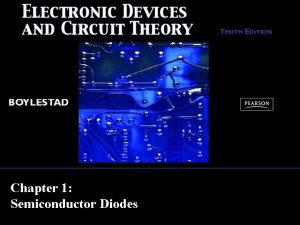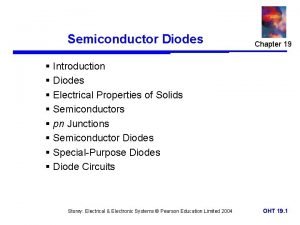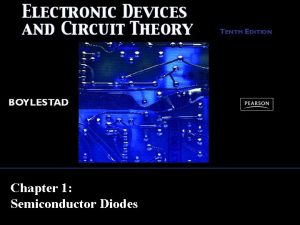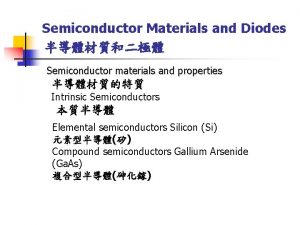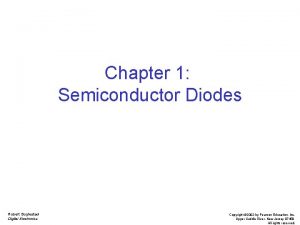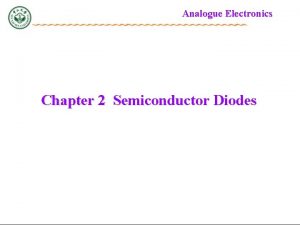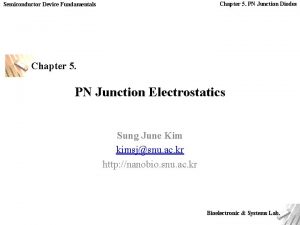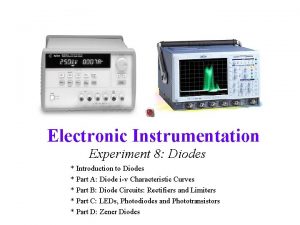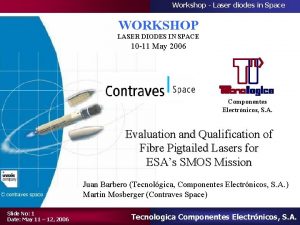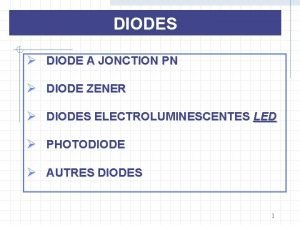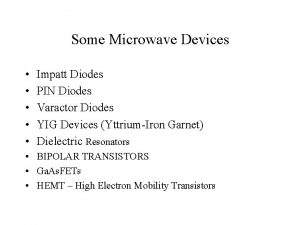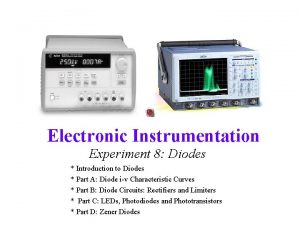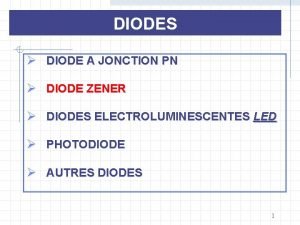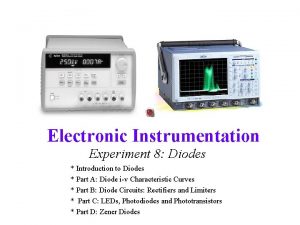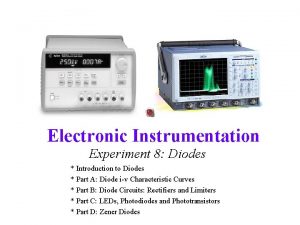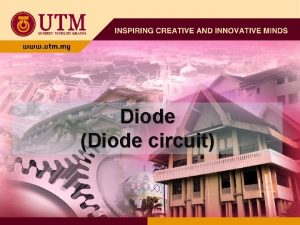Semiconductor Diodes Chapter 1 Semiconductor Diodes Diodes The
























- Slides: 24

Semiconductor Diodes Chapter 1: Semiconductor Diodes

Diodes The diode is a 2 -terminal device. A diode ideally conducts in only one direction. Electronic Devices and Circuit Theory, Robert L. Boylestad and Louis 10/e Nashelsky 2 Copyright © 2009 by Pearson Education, Inc. New Jersey 07458 • All rights reserved. Upper Saddle River,

Diode Characteristics Conduction Region Non-Conduction Region • The voltage across the diode is 0 V • The current is infinite • The forward resistance is defined as RF = V F / I F • The diode acts like a short Electronic Devices and Circuit Theory, Robert L. Boylestad and Louis 10/e Nashelsky 3 • All of the voltage is across the diode • The current is 0 A • The reverse resistance is defined as RR = V R / I R • The diode acts like open Copyright © 2009 by Pearson Education, Inc. New Jersey 07458 • All rights reserved. Upper Saddle River,

Semiconductor Materials commonly used in the development of semiconductor devices: • Silicon (Si) • Germanium (Ge) • Gallium Arsenide (Ga. As) Electronic Devices and Circuit Theory, Robert L. Boylestad and Louis 10/e Nashelsky 4 Copyright © 2009 by Pearson Education, Inc. New Jersey 07458 • All rights reserved. Upper Saddle River,

Doping The electrical characteristics of silicon and germanium are improved by adding materials in a process called doping. There are just two types of doped semiconductor materials: n-type p-type • n-type materials contain an excess of conduction band electrons. • p-type materials contain an excess of valence band holes. Electronic Devices and Circuit Theory, Robert L. Boylestad and Louis 10/e Nashelsky 5 Copyright © 2009 by Pearson Education, Inc. New Jersey 07458 • All rights reserved. Upper Saddle River,

p-n Junctions One end of a silicon or germanium crystal can be doped as a ptype material and the other end as an n-type material. The result is a p-n junction. Electronic Devices and Circuit Theory, Robert L. Boylestad and Louis 10/e Nashelsky 6 Copyright © 2009 by Pearson Education, Inc. New Jersey 07458 • All rights reserved. Upper Saddle River,

p-n Junctions At the p-n junction, the excess conduction-band electrons on the n-type side are attracted to the valence-band holes on the p-type side. The electrons in the n-type material migrate across the junction to the p-type material (electron flow). The electron migration results in a negative charge on the p-type side of the junction and a positive charge on the n-type side of the junction. Electronic Devices and Circuit Theory, Robert L. Boylestad and Louis 10/e Nashelsky 7 The result is the formation of a depletion region around the junction. Copyright © 2009 by Pearson Education, Inc. New Jersey 07458 • All rights reserved. Upper Saddle River,

Diode Operating Conditions A diode has three operating conditions: • No bias • Forward bias • Reverse bias Electronic Devices and Circuit Theory, Robert L. Boylestad and Louis 10/e Nashelsky 8 Copyright © 2009 by Pearson Education, Inc. New Jersey 07458 • All rights reserved. Upper Saddle River,

Diode Operating Conditions No Bias • No external voltage is applied: VD = 0 V • No current is flowing: ID = 0 A • Only a modest depletion region exists Electronic Devices and Circuit Theory, Robert L. Boylestad and Louis 10/e Nashelsky 9 Copyright © 2009 by Pearson Education, Inc. New Jersey 07458 • All rights reserved. Upper Saddle River,

Diode Operating Conditions Reverse Bias External voltage is applied across the p-n junction in the opposite polarity of the p- and n-type materials. • The reverse voltage causes the depletion region to widen. • The electrons in the n-type material are attracted toward the positive terminal of the voltage source. • The holes in the p-type material are attracted toward the negative terminal of the voltage source. Electronic Devices and Circuit Theory, 10/e Robert L. Boylestad and Louis Nashelsky 10 Copyright © 2009 by Pearson Education, Inc. Upper Saddle River, New Jersey 07458 • All rights reserved.

Diode Operating Conditions Forward Bias External voltage is applied across the p-n junction in the same polarity as the p- and n-type materials. • The forward voltage causes the depletion region to narrow. • The electrons and holes are pushed toward the p-n junction. • The electrons and holes have sufficient energy to cross the p-n junction. Electronic Devices and Circuit Theory, 10/e Robert L. Boylestad and Louis Nashelsky 11 Copyright © 2009 by Pearson Education, Inc. Upper Saddle River, New Jersey 07458 • All rights reserved.

Actual Diode Characteristics Note the regions for no bias, reverse bias, and forward bias conditions. Carefully note the scale for each of these conditions. Electronic Devices and Circuit Theory, 10/e Robert L. Boylestad and Louis Nashelsky 12 Copyright © 2009 by Pearson Education, Inc. Upper Saddle River, New Jersey 07458 • All rights reserved.

Majority and Minority Carriers Two currents through a diode: Majority Carriers • The majority carriers in n-type materials are electrons. • The majority carriers in p-type materials are holes. Minority Carriers • The minority carriers in n-type materials are holes. • The minority carriers in p-type materials are electrons. Electronic Devices and Circuit Theory, 10/e Robert L. Boylestad and Louis Nashelsky 13 Copyright © 2009 by Pearson Education, Inc. Upper Saddle River, New Jersey 07458 • All rights reserved.

Zener Region The Zener region is in the diode’s reverse-bias region. At some point the reverse bias voltage is so large the diode breaks down and the reverse current increases dramatically. • The maximum reverse voltage that won’t take a diode into the zener region is called the peak inverse voltage or peak reverse voltage. • The voltage that causes a diode to enter the zener region of operation is called the zener voltage (VZZ). Electronic Devices and Circuit Theory, Robert L. Boylestad and Louis 10/e Nashelsky 14 Copyright © 2009 by Pearson Education, Inc. New Jersey 07458 • All rights reserved. Upper Saddle River,

Forward Bias Voltage The point at which the diode changes from no-bias condition to forward-bias condition occurs when the electrons and holes are given sufficient energy to cross the p-n junction. This energy comes from the external voltage applied across the diode. The forward bias voltage required for a: • gallium arsenide diode ≅ 1. 2 V • silicon diode ≅ 0. 7 V • germanium diode ≅ 0. 3 V Electronic Devices and Circuit Theory, 10/e Robert L. Boylestad and Louis Nashelsky 15 Copyright © 2009 by Pearson Education, Inc. Upper Saddle River, New Jersey 07458 • All rights reserved.

Temperature Effects As temperature increases it adds energy to the diode. • It reduces the required forward bias voltage forwardbias conduction. • It increases the amount of reverse current in the reversebias condition. • It increases maximum reverse bias avalanche voltage. Germanium diodes are more sensitive to temperature variations than silicon or gallium arsenide diodes. Electronic Devices and Circuit Theory, 10/e Robert L. Boylestad and Louis Nashelsky 16 Copyright © 2009 by Pearson Education, Inc. Upper Saddle River, New Jersey 07458 • All rights reserved.

Diode Testing Diode checker Ohmmeter Electronic Devices and Circuit Theory, 10/e Robert L. Boylestad and Louis Nashelsky 26 Copyright © 2009 by Pearson Education, Inc. Upper Saddle River, New Jersey 07458 • All rights reserved.

Diode Checker Many digital multimeters have a diode checking function. The diode should be tested out of circuit. A normal diode exhibits forward voltage: • Gallium arsenide ≅ 1. 2 V • Silicon diode ≅ 0. 7 V • Germanium diode ≅ 0. 3 V Electronic Devices and Circuit Theory, 10/e Robert L. Boylestad and Louis Nashelsky 27 Copyright © 2009 by Pearson Education, Inc. Upper Saddle River, New Jersey 07458 • All rights reserved.

Ohmmeter An ohmmeter set on a low Ohms scale can be used to test a diode. The diode should be tested out of circuit. Electronic Devices and Circuit Theory, 10/e Robert L. Boylestad and Louis Nashelsky 28 Copyright © 2009 by Pearson Education, Inc. Upper Saddle River, New Jersey 07458 • All rights reserved.

Curve Tracer A curve tracer displays the characteristic curve of a diode in the test circuit. This curve can be compared to the specifications of the diode from a data sheet. Electronic Devices and Circuit Theory, 10/e Robert L. Boylestad and Louis Nashelsky 29 Copyright © 2009 by Pearson Education, Inc. Upper Saddle River, New Jersey 07458 • All rights reserved.

Other Types of Diodes Zener diode Light-emitting diode Diode arrays Electronic Devices and Circuit Theory, 10/e Robert L. Boylestad and Louis Nashelsky 30 Copyright © 2009 by Pearson Education, Inc. Upper Saddle River, New Jersey 07458 • All rights reserved.

Zener Diode A Zener is a diode operated in reverse bias at the Zener voltage (VZ). Common Zener voltages are between 1. 8 V and 200 V Electronic Devices and Circuit Theory, 10/e Robert L. Boylestad and Louis Nashelsky 31 Copyright © 2009 by Pearson Education, Inc. Upper Saddle River, New Jersey 07458 • All rights reserved.

Light-Emitting Diode (LED) An LED emits photons when it is forward biased. These can be in the infrared or visible spectrum. The forward bias voltage is usually in the range of 2 V to 3 V. Electronic Devices and Circuit Theory, 10/e Robert L. Boylestad and Louis Nashelsky 32 Copyright © 2009 by Pearson Education, Inc. Upper Saddle River, New Jersey 07458 • All rights reserved.

Diode Arrays Multiple diodes can be packaged together in an integrated circuit (IC). Common Anode A variety of combinations exist. Electronic Devices and Circuit Theory, Robert L. Boylestad and Louis 10/e Nashelsky Common Cathode 33 Copyright © 2009 by Pearson Education, Inc. New Jersey 07458 • All rights reserved. Upper Saddle River,
 Hình ảnh bộ gõ cơ thể búng tay
Hình ảnh bộ gõ cơ thể búng tay Lp html
Lp html Bổ thể
Bổ thể Tỉ lệ cơ thể trẻ em
Tỉ lệ cơ thể trẻ em Gấu đi như thế nào
Gấu đi như thế nào Tư thế worm breton là gì
Tư thế worm breton là gì Hát lên người ơi
Hát lên người ơi Kể tên các môn thể thao
Kể tên các môn thể thao Thế nào là hệ số cao nhất
Thế nào là hệ số cao nhất Các châu lục và đại dương trên thế giới
Các châu lục và đại dương trên thế giới Cong thức tính động năng
Cong thức tính động năng Trời xanh đây là của chúng ta thể thơ
Trời xanh đây là của chúng ta thể thơ Mật thư tọa độ 5x5
Mật thư tọa độ 5x5 101012 bằng
101012 bằng độ dài liên kết
độ dài liên kết Các châu lục và đại dương trên thế giới
Các châu lục và đại dương trên thế giới Thơ thất ngôn tứ tuyệt đường luật
Thơ thất ngôn tứ tuyệt đường luật Quá trình desamine hóa có thể tạo ra
Quá trình desamine hóa có thể tạo ra Một số thể thơ truyền thống
Một số thể thơ truyền thống Cái miệng nó xinh thế chỉ nói điều hay thôi
Cái miệng nó xinh thế chỉ nói điều hay thôi Vẽ hình chiếu vuông góc của vật thể sau
Vẽ hình chiếu vuông góc của vật thể sau Thế nào là sự mỏi cơ
Thế nào là sự mỏi cơ đặc điểm cơ thể của người tối cổ
đặc điểm cơ thể của người tối cổ Ví dụ về giọng cùng tên
Ví dụ về giọng cùng tên Vẽ hình chiếu đứng bằng cạnh của vật thể
Vẽ hình chiếu đứng bằng cạnh của vật thể


























